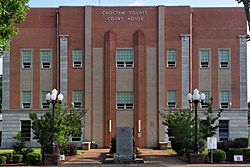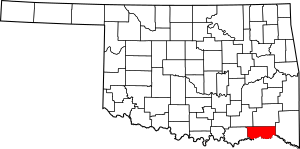Choctaw County, Oklahoma facts for kids
Quick facts for kids
Choctaw County
|
|
|---|---|

The Choctaw County Courthouse in Hugo.
|
|

Location within the U.S. state of Oklahoma
|
|
 Oklahoma's location within the U.S. |
|
| Country | |
| State | |
| Founded | 1907 |
| Seat | Hugo |
| Largest city | Hugo |
| Area | |
| • Total | 800 sq mi (2,000 km2) |
| • Land | 770 sq mi (2,000 km2) |
| • Water | 29 sq mi (80 km2) 3.7%% |
| Population
(2020)
|
|
| • Total | 14,204 |
| • Density | 17.8/sq mi (6.9/km2) |
| Time zone | UTC−6 (Central) |
| • Summer (DST) | UTC−5 (CDT) |
| Congressional district | 2nd |
Choctaw County is a county located in the U.S. state of Oklahoma. As of the 2020 census, the population was 14,204. Its county seat is Hugo.
Formerly part of the Choctaw Nation in Indian Territory, this county was reorganized and redefined in 1907, at the time of Oklahoma statehood. According to the Encyclopedia of Oklahoma History and Culture, the name is derived from Chahta, the mythical founder of the Choctaw people. It is part of the area of jurisdiction of the Choctaw Nation of Oklahoma.
Contents
History
The Choctaw Nation moved into the area now occupied by Choctaw County in 1831–1832, as a result of their forcible removal from their homeland in the Southeastern United States, under the Indian Removal Act. The US wanted to extinguish Native American land claims in the Southeast to enable development by European Americans. It offered land in exchange in Indian Territory.
The U.S. Army had already established Fort Towson in the western area in 1824, and took on the mission of protecting the newcomers from other tribes. In 1837, the Chickasaw were also removed, and settled the area around Doaksville, which was adjacent to the fort. Both the town of Fort Towson and Doaksville served as the capital of the Choctaw Nation. Doaksville became a ghost town after the Civil War. In 1848, the Presbyterian church established a mission, which still exists and is now known as Goodland Academy.
The St. Louis and San Francisco Railway built a line through the town of Hugo in 1902, stimulating commercial development of the town as a regional center. Before statehood, the area of Choctaw County was part of Jackson, Kiamichi, Cedar, and Towson counties, Choctaw Nation. It included two of the three provinces, or districts, comprising the Choctaw Nation: the Apukshunnubbee District and the Pushmataha District.
As the end of the Indian Territory drew near, tribal citizens and other inhabitants organized an effort for the territory to be admitted to the Union as a state. The State of Sequoyah, which they proposed, divided the territories of the five tribes into counties. Hugo was designated as the county seat of Hitchcock County. Although neither Congress nor the president were interested in admitting Sequoyah as a state, the county boundaries proposed for Sequoyah were in some cases adopted for counties in the future state of Oklahoma.
In southeastern Oklahoma, the future Choctaw County's boundaries were generally those of Hitchcock County, Sequoyah. Similarly, boundaries proposed for Pushmataha County, Sequoyah served, in general, as the boundaries for Pushmataha County, Oklahoma. And McCurtain County, Oklahoma generally follows the boundaries proposed for McCurtain County, Sequoyah. Both counties are adjacent to and share boundaries with Choctaw County.
When Oklahoma became a state in 1907, Choctaw County was created and Hugo was named as the county seat.
Recent events
In October 2011 the U.S. Navy announced plans to honor Choctaw County with the naming of a ship. The Joint High Speed Vessel (JHSV) will simultaneously honor the three American counties named Choctaw County, in the states of Alabama, Mississippi, and Oklahoma. "I grew up in Choctaw County, Miss., where people work hard to raise their families and provide for their children," Secretary of the Navy Ray Mabus said in announcing the plan. "I chose to name JHSV after Choctaw County to honor those men and women who represent rural America." USNS Choctaw County will bear hull number JHSV-2.
Geography
Choctaw County is in southeastern Oklahoma, in a 10-county area designated for tourism purposes by the Oklahoma Department of Tourism and Recreation as Choctaw Country. According to the U.S. Census Bureau, the county has a total area of 800 square miles (2,100 km2), of which 770 square miles (2,000 km2) is land and 29 square miles (75 km2) (3.7%) is water. The major streams in the county are the Kiamichi River, the Muddy Boggy River and the Clear Boggy River, which all drain into the Red River. Lakes include Hugo Lake, on the Kiamichi River, and Raymond Gary Lake. Choctaw County is the only documented part of Oklahoma, together with McCurtain County, located within the natural range of the American alligator.
Major highways
Adjacent counties
- Pushmataha County (north)
- McCurtain County (east)
- Red River County, Texas (southeast)
- Lamar County, Texas (south)
- Bryan County (west)
- Atoka County (northwest)
Demographics
| Historical population | |||
|---|---|---|---|
| Census | Pop. | %± | |
| 1910 | 21,862 | — | |
| 1920 | 32,144 | 47.0% | |
| 1930 | 24,142 | −24.9% | |
| 1940 | 28,358 | 17.5% | |
| 1950 | 20,405 | −28.0% | |
| 1960 | 15,637 | −23.4% | |
| 1970 | 15,141 | −3.2% | |
| 1980 | 17,203 | 13.6% | |
| 1990 | 15,302 | −11.1% | |
| 2000 | 15,342 | 0.3% | |
| 2010 | 15,205 | −0.9% | |
| 2020 | 14,204 | −6.6% | |
| U.S. Decennial Census 1790-1960 1900-1990 1990-2000 2010 |
|||
As of the census of 2000, there were 15,342 people, 6,220 households, and 4,285 families residing in the county. The population density was 20 people per square mile (8 people/km2). There were 7,539 housing units at an average density of 10 units per square mile (4/km2). The racial makeup of the county was 68.55% White, 10.94% Black or African American, 14.96% Native American, 0.16% Asian, 0.02% Pacific Islander, 0.48% from other races, and 4.90% from two or more races. 1.60% of the population were Hispanic or Latino of any race. 97.1% spoke English, 1.6% Spanish and 1.3% Choctaw as their first language.
There were 6,220 households, out of which 30.00% had children under the age of 18 living with them, 51.30% were married couples living together, 14.40% had a female householder with no husband present, and 31.10% were non-families. 28.30% of all households were made up of individuals, and 14.90% had someone living alone who was 65 years of age or older. The average household size was 2.43 and the average family size was 2.96.
In the county, the population was spread out, with 26.00% under the age of 18, 7.80% from 18 to 24, 24.70% from 25 to 44, 24.10% from 45 to 64, and 17.40% who were 65 years of age or older. The median age was 39 years. For every 100 females there were 90.40 males. For every 100 females age 18 and over, there were 85.00 males.
The median income for a household in the county was $22,743, and the median income for a family was $28,331. Males had a median income of $25,777 versus $18,805 for females. The per capita income for the county was $12,296. About 20.40% of families and 24.30% of the population were below the poverty line, including 32.50% of those under age 18 and 21.70% of those age 65 or over.
Economy
Agriculture, ranching and lumber have been the mainstays of the county economy since statehood. In 1910, cotton was the main crop. By 1930, the local agriculture industry had diversified to include corn, oats, prairie hay, and peanuts. At the start of the 21st century, soybeans, vegetables, and corn were the main crops. Retail businesses and health care were the largest employers.
Communities
City
- Hugo (county seat)
Towns
Census-designated places
Other unincorporated places
See also
 In Spanish: Condado de Choctaw (Oklahoma) para niños
In Spanish: Condado de Choctaw (Oklahoma) para niños



